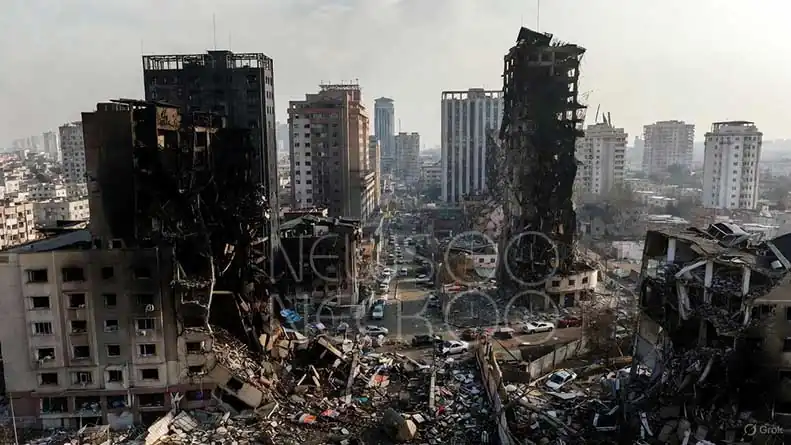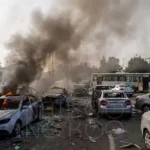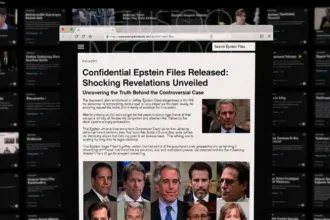As residents huddled in corridors and shelters, Ukraine’s capital faced one of its most intense bombardments. Six people died. President Zelenskyy is now calling it Trump’s war too.
The air raid sirens started wailing just after midnight. Across Kyiv, the ritual began again—the same ritual that has repeated countless times since Russia invaded Ukraine nearly three years ago.
People grabbed their children. They gathered essential documents. Some hurried to shelters in basements or metro stations. Others, too tired or too resigned to run, lay down between two walls in their apartments, hoping the structure would protect them if a missile struck nearby.
Then came the sound every resident of Kyiv has learned to dread: the distinctive whine of Shahed drones overhead, followed by the staccato rhythm of heavy machine-gun fire as Ukrainian air defenses tried to shoot them down.
This wasn’t just another attack. This was something different—larger, more sustained, more calculated. By the time dawn broke on Friday, Ukraine’s president would report that Russia had launched 430 drones and 18 missiles at targets across the country. Six people were dead in Kyiv alone. Dozens more were injured.
“Deliberate, calculated and wicked,” President Volodymyr Zelenskyy called it. And he added something new to his condemnation: a message directed at the American president who promised to end this war.
The Night the Sky Exploded
At 3 a.m., a drone slammed into the upper floors of a multistory residential building in Kyiv’s Sviatoshynskyi district. Witnesses described a fireball lighting up the night sky.
Bruce Avalord, an American who has lived in Kyiv for years, was among those who heard the explosion. “It was scary. Our windows shook. I thought: ‘Oh God, this is the end,'” he said the next morning, standing outside the wrecked building.
Inside, six people were dead. They had been at home, in their beds, when the drone hit. There was no warning beyond the sirens that sound so often they’ve become background noise in Ukrainian life.
By Friday morning, a bulldozer was scooping up glass and bricks that had fallen onto the pavement. Car owners surveyed their vehicles, windows shattered, bodies dented by debris. The Azerbaijani embassy nearby was struck by falling wreckage.
“There are no military targets here, just civilians,” Avalord said, gesturing at the apartment blocks surrounding him. “The Russians want people to beg the government to capitulate. The tactic won’t work; Ukrainians are resilient.”
Another resident, Valentina, described how she threw on her clothes and hid in her ninth-floor corridor next to the elevator, staying there until dawn. “The explosions woke me up. It was very loud. There were booms everywhere,” she recalled. “I was messaging friends to see if they were OK.”
About 30 residential buildings were targeted across Ukraine. Five people, including a pregnant woman, were taken to hospital. Several children were hurt.
Prime Minister Yulia Svyrydenko called the bombardment “unprecedented.”
The Pattern Behind the Attack
This wasn’t random violence. According to Ukrainian officials and military analysts, Friday’s assault followed a pattern that has become grimly familiar: Russia launches waves of relatively cheap Shahed drones—Iranian-designed suicide drones that cost a fraction of sophisticated missiles—mixed with more expensive and harder-to-intercept cruise and ballistic missiles.
The drones serve multiple purposes. Some carry warheads meant to cause damage. Others are decoys, forcing Ukraine to expend expensive air defense missiles or reveal the locations of defense systems. Behind the drone swarm come the real threats: precision missiles targeting infrastructure, military facilities, or simply terrorizing civilian populations.
The goal, according to Western intelligence assessments, is twofold: exhaust Ukraine’s air defense capabilities and break civilian morale. Make life in Ukrainian cities so unbearable that ordinary people pressure their government to negotiate on Russian terms.
So far, it hasn’t worked. But the cost—in lives, in resources, in psychological toll—keeps mounting.
Zelenskyy’s New Message
In his response to Friday’s attack, President Zelenskyy made his usual appeals: Europe and the United States must supply additional air defense systems. Further sanctions must be imposed on Russia’s oil industry, the financial engine funding Putin’s war machine.
But he also disclosed something significant: Ukraine has started hitting back with newly developed long-range weapons. He confirmed that “Long Neptune” missiles had been used for the first time in a successful Ukrainian strike on Novorossiysk, a Russian Black Sea port and major oil export facility.
“Our entirely just response to Russia’s ongoing terror,” Zelenskyy called it.
The revelation signals Ukraine’s increasing capability to strike deep inside Russian territory using domestically produced weapons—a development that could reshape the strategic calculations on both sides.
But Zelenskyy also sent a pointed message to Washington, and specifically to President Donald Trump.
“Now It Is Also Trump’s War”
During his last visit to the White House in October, Zelenskyy asked Trump for long-range Tomahawk missiles. Trump has so far refused, reportedly wary of escalating tensions with Russia and concerned about the Kremlin’s threats of retaliation.
Oleksandra Matviichuk, Ukraine’s Nobel Peace Prize laureate, didn’t mince words in her assessment. “Trump promised that when he becomes president, he will end the Russian war against Ukraine,” she wrote on social media after Friday’s attack. “Putin is demonstratively obstructing all his efforts even simply to cease fire.”
Then came the challenge: “Now it is also Trump’s war. If he does not show strength, he will go down in history as a weak president.”
The statement represents a significant shift in how Ukrainian leaders are framing the conflict. For nearly three years, this has been Ukraine’s war, with Western support. Now, with Trump in office and promising to broker peace, Ukrainian officials are making clear: if Putin continues these attacks, it reflects on Trump’s ability to deliver on his promises.
It’s a calculated gamble. By making it “Trump’s war” too, Ukraine hopes to pressure the American president into providing more substantial support—or at least into using his leverage with Putin more forcefully.
The Weapons Ukraine Needs
Matviichuk and other Ukrainian officials argue that the key to stopping attacks like Friday’s assault isn’t just shooting down drones and missiles after they’re launched. It’s destroying them before they take off—hitting Russian military airfields, weapons depots, and launch sites deep inside Russian territory.
That requires long-range missiles like the Tomahawks Zelenskyy requested. The United States has been reluctant to provide them, fearing such weapons could be used to strike targets deep in Russia, potentially triggering a wider conflict.
Ukraine argues the opposite: only by making Russia’s war costly on Russian soil will Putin be forced to negotiate seriously.
Matviichuk called on European countries to use their air power to help defend Ukraine’s skies—a proposal that would represent a dramatic escalation of Western involvement but one that’s gaining traction among some European lawmakers tired of watching Russian attacks on civilians.
The International Response
Germany’s defense minister, Boris Pistorius, condemned Friday’s attack, saying Vladimir Putin had shown “contempt for humanity.”
Similar condemnations came from other European capitals, as they have after countless previous attacks. But condemnations don’t stop missiles. And as Ukraine enters its third winter of war, the question facing Western leaders is whether moral outrage will translate into the military support Ukraine says it needs to defend its cities.
What Comes Next
By Friday afternoon, Kyiv was cleaning up. Glass was swept from streets. Damaged windows were boarded up. Life continued, as it must when war becomes routine.
But the fundamental questions remain unresolved: How long can Ukraine sustain its defense without advanced long-range weapons? Will Trump use his promised leverage with Putin to stop attacks on civilians? And how many more nights will Ukrainian families spend in corridors and shelters, waiting for the all-clear signal that means they’ve survived another bombardment?
Bruce Avalord, the American resident standing outside the wrecked apartment building, offered his assessment: “Ukrainians are resilient.”
They may need to be. Because nothing in Friday’s massive attack—or in the international response to it—suggests this war is anywhere close to ending.
Based on reports from Kyiv and Ukrainian government statements, November 2025.













